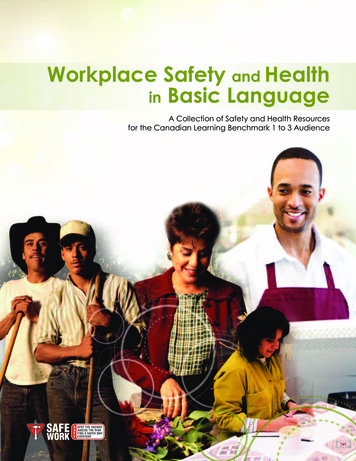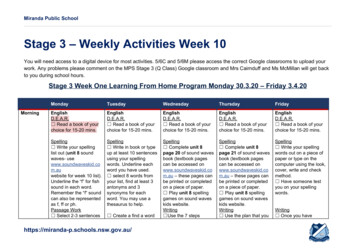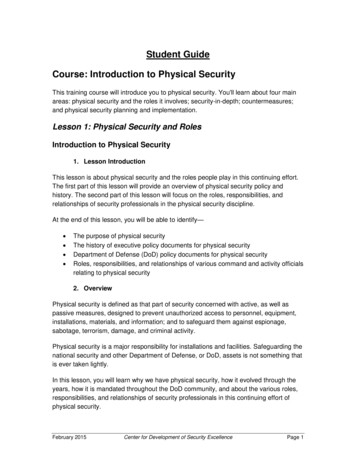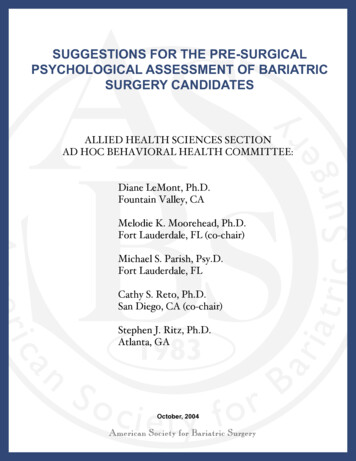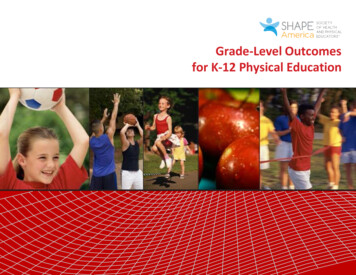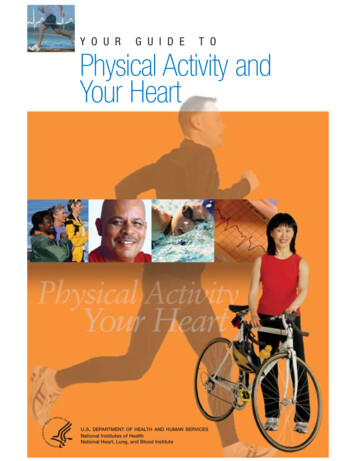
Transcription
Y O U RG U I D ET OPhysical Activity andYour HeartU.S. DEPARTMENT OF HEALTH AND HUMAN SERVICESNational Institutes of HealthNational Heart, Lung, and Blood Institute
YOURGUIDE TOPhysical Activity andYour HeartU.S. DEPARTMENT OF HEALTH AND HUMAN SERVICESNational Institutes of HealthNational Heart, Lung, and Blood InstituteNIH Publication No. 06-5714June 2006
U.S. DEPARTMENT OF HEALTH AND HUMAN SERVICESNational Institutes of HealthNational Heart, Lung, and Blood Institute
ContentsOn the Move . . . . . . . . . . . . . . . . . . . . . . . . . . . . . . . . . . . . . . . . . . . . . . . . . 1Physical Activity and Your Health . . . . . . . . . . . . . . . . . . . . . . . . . . . . . . . . 3Physical Activity: The Heart Connection. . . . . . . . . . . . . . . . . . . . . . . . . . . . 4Heart Disease Risk Factors . . . . . . . . . . . . . . . . . . . . . . . . . . . . . . . . . . . . . 5You Have Control . . . . . . . . . . . . . . . . . . . . . . . . . . . . . . . . . . . . . . . . . . 6Eight Tips for Heart Health . . . . . . . . . . . . . . . . . . . . . . . . . . . . . . . . . . . 7Physical Activity: The Calorie Connection . . . . . . . . . . . . . . . . . . . . . . . . . . 7The Benefits Keep Coming . . . . . . . . . . . . . . . . . . . . . . . . . . . . . . . . . . . . . 8Go for the Burn! . . . . . . . . . . . . . . . . . . . . . . . . . . . . . . . . . . . . . . . . . . . 9Great Moves . . . . . . . . . . . . . . . . . . . . . . . . . . . . . . . . . . . . . . . . . . . . . . . . 11Types of Physical Activity . . . . . . . . . . . . . . . . . . . . . . . . . . . . . . . . . . . . . 11Working Together for Health . . . . . . . . . . . . . . . . . . . . . . . . . . . . . . . . . . . 11A Complete Activity Program. . . . . . . . . . . . . . . . . . . . . . . . . . . . . . . . . 12Three Moves for Health . . . . . . . . . . . . . . . . . . . . . . . . . . . . . . . . . . . . 13Intensity Levels . . . . . . . . . . . . . . . . . . . . . . . . . . . . . . . . . . . . . . . . . . . . 14Choosing Your Moves . . . . . . . . . . . . . . . . . . . . . . . . . . . . . . . . . . . . . . 15Getting in Motion . . . . . . . . . . . . . . . . . . . . . . . . . . . . . . . . . . . . . . . . . . . . 17Exploding the Myths . . . . . . . . . . . . . . . . . . . . . . . . . . . . . . . . . . . . . . . . . 17Taking Precautions . . . . . . . . . . . . . . . . . . . . . . . . . . . . . . . . . . . . . . . . . . 19Choosing the Right Activity . . . . . . . . . . . . . . . . . . . . . . . . . . . . . . . . . . . . 20Smart Moves . . . . . . . . . . . . . . . . . . . . . . . . . . . . . . . . . . . . . . . . . . . . . . 23Tracking Your Target Heart Rate. . . . . . . . . . . . . . . . . . . . . . . . . . . . . . . . . 24Finding Your Target Heart Rate Zone . . . . . . . . . . . . . . . . . . . . . . . . . . . 25A Sample Walking Program. . . . . . . . . . . . . . . . . . . . . . . . . . . . . . . . . . 27A Sample Jogging Program . . . . . . . . . . . . . . . . . . . . . . . . . . . . . . . . . 28ContentsPlaying It Safe . . . . . . . . . . . . . . . . . . . . . . . . . . . . . . . . . . . . . . . . . . . . . . 31Avoid Injury . . . . . . . . . . . . . . . . . . . . . . . . . . . . . . . . . . . . . . . . . . . . . . . 31Eat Right . . . . . . . . . . . . . . . . . . . . . . . . . . . . . . . . . . . . . . . . . . . . . . . . . 32Check the Weather Report . . . . . . . . . . . . . . . . . . . . . . . . . . . . . . . . . . . . 32Taking Too Much Heat . . . . . . . . . . . . . . . . . . . . . . . . . . . . . . . . . . . . . 33Seek Company. . . . . . . . . . . . . . . . . . . . . . . . . . . . . . . . . . . . . . . . . . . . . 34Know the Signs of a Heart Problem . . . . . . . . . . . . . . . . . . . . . . . . . . . . . . 34Get Back in the Swing . . . . . . . . . . . . . . . . . . . . . . . . . . . . . . . . . . . . . . . 34
ivStaying Active . . . . . . . . . . . . . . . . . . . . . . . . . . . . . . . . . . . . . . . . . . . . . . 37Motivation Makers . . . . . . . . . . . . . . . . . . . . . . . . . . . . . . . . . . . . . . . . . . 37Creating Opportunities . . . . . . . . . . . . . . . . . . . . . . . . . . . . . . . . . . . . . . . 38Family Fitness . . . . . . . . . . . . . . . . . . . . . . . . . . . . . . . . . . . . . . . . . . . 39Measuring Your Mileage . . . . . . . . . . . . . . . . . . . . . . . . . . . . . . . . . . . . 40Moving Toward Health . . . . . . . . . . . . . . . . . . . . . . . . . . . . . . . . . . . . . . . . 41To Learn More . . . . . . . . . . . . . . . . . . . . . . . . . . . . . . . . . . . . . . . . . . . . . . 43
1On the MoveChances are, you already know that physical activity is good foryou. “Sure,” you may say. “When I get out and move around, Iknow it helps me to feel and look better.” But you may not realizejust how important regular physical activity is to your health.According to the U.S. Surgeon General’s Report on Physical Activityand Health, inactive people are nearly twice as likely to developheart disease as those who are more active. This is true even if youhave no other conditions or habits that increase your risk for heartdisease. Lack of physical activity also leads to more visits to thedoctor, more hospitalizations, and more use of medicines for avariety of illnesses.The good news is that physical activity can protect your heart in anumber of important ways. Moreover, to get benefits, you don’thave to run a marathon. Regular activity—something as simple as abrisk, 30-minute walk each day—can help you to reduce your riskof heart disease.This booklet will help you to understand the impact of physicalactivity on your heart, as well as the power of regular activity tohelp keep you healthy overall. It will also offer plenty of ideas onstarting a physical activity program that will be both healthful andenjoyable. Just as important, you’ll get tips for keeping up with theactivity or activities you choose, since staying active over time isimportant to long-term health. So use this booklet often for information, ideas, and to keep you motivated. When to start getting fit?There’s no time like today.On the Move
2ALAN“ANDLILALETOWExercise and taking good care of ourselvesare important parts of our life plan. Lila andI exercise regularly and look to not onlycardiovascular and strength building exercises,but also to improving our muscle flexibility andrange of motion. Hopefully, this should keep usfit for the years ahead.”
3Physical Activity andYour HealthIf you currently get regular physical activity, congratulations! Butif you’re not yet getting all the activity you need, you have lotsof company. According to the Centers for Disease Control andPrevention (CDC), 60 percent of Americans are not meeting therecommended levels of physical activity. Fully 16 percent ofAmericans are not active at all. Overall, women tend to be lessactive than men, and older people are less likely to get regularphysical activity than younger individuals.What does it mean to get “regular physical activity?” To reduce therisk of heart disease, adults need only do about 30 minutes of moderate activity on most, and preferably all, days of the week. This levelof activity can also lower your chances of having a stroke, coloncancer, high blood pressure, diabetes, and other medical problems.If you’re also trying to manage your weight and prevent gradual,unhealthy weight gain, try to get 60 minutes of moderate- tovigorous-intensity activity on most days of the week. At the sametime, watch your calories. Take in only enough calories to maintainyour weight. Those who are trying to keep weight off should aima bit higher: Try to get 60–90 minutes of moderate-intensity activitydaily, without taking in extra calories. Later in the book, you’ll findout more about the types of activities that you can easily fit intoyour routine, as well as ways to break up your activity time intomanageable segments.Physical Activity and Your HealthIf you’re not as active as you might be, take a moment to considerwhy. Maybe you’re just in the habit of traveling by car or bus, evenwhen you’re not going far. In your free time, perhaps it’s temptingto sit down in front of the TV or computer rather than do somethingmore vigorous. It’s easy to get busy or tired and decide that it’s justsimpler to put off that brisk walk or bike ride. But when you thinkabout the serious problems that physical inactivity can create foryour health—and the enormous rewards of getting regular activity—
4you may want to reconsider. Let’s start with the ways that physicalactivity affects your heart.Physical Activity: The Heart ConnectionIt’s worth repeating: Physical inactivity greatly increases your riskof developing heart disease. Heart disease occurs when the arteriesthat supply blood to the heart muscle become hardened andnarrowed, due to a buildup of plaque on the arteries’ inner walls.Plaque is the accumulation of fat, cholesterol, and other substances.As plaque continues to build up in the arteries, blood flow to theheart is reduced.Your Guide to Physical Activity and Your HeartHeart disease can lead to a heart attack. A heart attack happenswhen a cholesterol-rich plaque bursts and releases its contents intothe bloodstream. This causes a blood clot to form over the plaque,totally blocking blood flow through the artery and preventing vitaloxygen and nutrients from getting to theheart. A heart attack can cause permanent damage to the heart muscle.Some people aren’t too concernedabout heart disease because theythink it can be cured with surgery.This is a myth. Heart disease isa lifelong condition. It’s truethat certain procedures canhelp blood and oxygen flowmore easily to the heart.But the arteries remain damaged, which means you arestill more likely tohave a heart attack.What’s more, thecondition of yourbloodvessels will steadilyworsen unless youmake changes in yourdaily habits and controlother factors thatincrease risk.
5Heart disease is a serious disease—and too often, a fatal one. It isthe number one killer of Americans, with 500,000 people in theUnited States dying of heart disease each year. Many others withheart problems become permanently disabled. That’s why it’s sovital to take action to prevent this disease. Getting regular physicalactivity should be part of everyone’s heart disease prevention program.Heart Disease Risk FactorsRisk factors are conditions or habits that make a person more likelyto develop a disease. They can also increase the chances that anexisting disease will get worse. Certain risk factors for heartdisease, such as getting older or having a family history of earlyheart disease, can’t be changed. But physical inactivity is a majorrisk factor for heart disease that you have control over. You canmake a decision to get regular physical activity, and this booklet canhelp you create a workable, enjoyable program that will help youprotect your heart.Other major risk factors for heart disease that you can change aresmoking, high blood pressure, high blood cholesterol, overweight,and diabetes. (See the box, “You Have Control,” on page 6.)Every risk factor counts. Research shows that each individual riskfactor greatly increases the chances of developing heart disease andhaving a heart attack. A damaged heart can damage your life, byinterfering with enjoyable activities and even keeping you fromdoing simple things, such as taking a walk or climbing steps.Physical Activity and Your HealthBut it’s important to know that you have a lot of power to protectyour heart health. (See the box, “Eight Tips for Heart Health,” onpage 7.) Getting regular physical activity is an especially importantpart of your healthy heart program, because physical activity bothdirectly reduces your heart disease risk and reduces your chancesof developing other risk factors for heart disease. For example,regular physical activity may reduce LDL (bad) cholesterol, increaseHDL (good) cholesterol, and lower high blood pressure. It canalso protect your heart by helping to prevent and control diabetes.Finally, physical activity can help you to lose excess weight or stayat your desirable weight, which will also help to lower your risk of
6You Have ControlPhysical inactivity is one of several major risk factors for heart diseasethat you can do something about. The others are:Smoking. People who smoke are up to six times more likely to suffer aheart attack than nonsmokers, and the risk increases with the number ofcigarettes smoked each day. Quitting will greatly reduce your risk.Check with local community groups for free or low-cost programsdesigned to help people stop smoking.High Blood Pressure. Also known as hypertension, high bloodpressure increases your risk of heart disease, stroke, kidney disease, andcongestive heart failure. Your health care provider can check your bloodpressure by means of a simple test using an inflatable arm cuff. Bloodpressure often can be entirely controlled by getting regular physicalactivity, losing excess weight, cutting down on alcohol, and changingeating habits, such as using less salt and other forms of sodium. Forsome people, medication is also needed.Your Guide to Physical Activity and Your HeartHigh Blood Cholesterol. High blood cholesterol can lead to thebuildup of plaque in your arteries, which raises the risk of a heart attack.Starting at age 20, everyone should have their cholesterol levels checkedby means of a blood test called a “lipoprotein profile.” You can lowerhigh blood cholesterol by getting regular physical activity, eating lesssaturated fat and trans fat, and managing your weight. In some cases,medication is also needed.Overweight. If you are overweight or obese, you are more likely todevelop heart disease even if you have no other risk factors. Ask yourdoctor to help you determine whether you need to lose weight foryour health. The good news: Losing just 5–10 percent of your currentweight will help to lower your risk of heart disease and many othermedical disorders.Diabetes greatly increases your risk for heart disease, stroke, and otherserious diseases. Ask your doctor whether you should be tested for it.Many people at high risk for diabetes can prevent or delay the diseaseby reducing calories as part of a healthy eating plan, and by becomingmore physically active. If you already have diabetes, work closely withyour doctor to manage it.
7Eight Tips for Heart Health Become—and stay—physically active.Balance your calorie intake with the calories you burn in physical activity.Lose weight if you’re overweight.If you smoke, stop. Avoid other people’s smoke if you can.Control high blood pressure.Control high blood cholesterol.Control diabetes.Choose foods low in saturated fat, trans fat, cholesterol, sugar, and salt.Enjoy more fruits, vegetables, and whole grains.heart disease.Physical Activity: The Calorie ConnectionOne way that regular physical activity protects against heart diseaseis by burning extra calories, which helps you to lose excess weightor stay at your desirable weight. To understand how physicalactivity affects calories, it is helpful to consider the concept of“energy balance.” Energy balance is the amount of calories you takein relative to the amount of calories you burn. Per week, you needto burn off about 3,500 more calories than you take in to lose1 pound. If you need to lose weight for your health, regularphysical activity can help you through one of two approaches.First, you can choose to eat your usual amount of calories, but bemore active. For example, a 200-pound person who keeps oneating the same amount of calories, but begins to walk brisklyeach day for 11/2 miles, will lose about 14 pounds in 1 year. Stayingactive will also help to keep the weight off.Most of the energy you burn each day—about three quarters of it—Physical Activity and Your HealthSecond, you can eat fewer calories and be more active. This is thebest way to lose weight, since you’re more likely to be successfulby combining a healthful, lower-calorie diet with physical activity.For example, a 200-pound person who consumes 250 fewer caloriesper day, and begins to walk briskly each day for 11/2 miles, will loseabout 40 pounds in 1 year.
8goes to activities that your body automatically engages in for survival,such as breathing, sleeping, and digesting food. The part of yourenergy output that you control is daily physical activity. Any activityyou take part in beyond your body’s automatic activities will burnextra calories. Even seated activities, such as using the computer orwatching TV, will burn calories—but only a very small number.That’s why it’s important to make time each day for moderate-tovigorous physical activity.The Benefits Keep ComingIt is hard to imagine a single practice with more health benefits thanregular physical activity. In addition to protecting your heart innumerous ways, staying active: May help to prevent cancers of the breast, uterus, and colon. Strengthens your lungs and helps them to work more efficiently. Tones and strengthens your muscles. Builds stamina. Keeps your joints in good condition. Improves balance. May slow bone loss.Your Guide to Physical Activity and Your HeartRegular physical activity can also boost the way you feel. It may: Give you more energy. Help you to relax and cope better with stress. Build confidence. Allow you to fall asleep more quickly and sleep more soundly. Help you to beat the blues. Provide an enjoyable way to share time with friends or family.
9Go for the Burn!Some physical activities burn more calories than others. Below are theaverage number of calories a 154-pound person will burn, per hour, fora variety of activities. (A lighter person will burn fewer calories; a heavierperson will burn more.) As you can see, vigorous-intensity activitiesburn more calories than moderate-intensity activities.Moderate Physical ActivityCalories Burned per HourHikingLight gardening/yard workDancingGolf (walking and carrying clubs)Bicycling (less than 10 mph)Walking (3.5 mph)Weight lifting (light workout)Stretching370330330330290280220180Vigorous Physical ActivityRunning/joggingBicycling (more than 10 mph)Swimming (slow freestyle laps)AerobicsWalking (4.5 mph)Heavy yard work (chopping wood,for example)Weight lifting (vigorous workout)Basketball (vigorous)Calories Burned per Hour590590510480460440440440Physical Activity and Your HealthSource: Adapted from the 2005 Dietary Guidelines Advisory Committee Report
10L I LY“KRAMERI think exercise is extremely important.Whenever I feel stressed out, I go to thegym and work out. I come out of therefeeling much better.Your Guide to Physical Activity and Your Heart”
11Great MovesGiven the numerous benefits of regular physical activity, you maybe ready to get in motion! But first, it’s important to know howactivities differ from one another and how each form of movementuniquely contributes to your health. Three types of activity areimportant for a complete physical activity program: aerobic activity,resistance training, and flexibility exercises. Let’s take a brief lookat each one.Types of Physical ActivityAerobic activity is any physical activity that uses large musclegroups and causes your body to use more oxygen than it wouldwhile resting. This booklet focuses mainly on aerobic activitybecause it is the type of movement that most benefits the heart.Examples of aerobic activity are brisk walking, jogging, andbicycling.Resistance training—also called strength training—can firm,strengthen, and tone your muscles, as well as improve bonestrength, balance, and coordination. Examples of strength movesare pushups, lunges, and bicep curls using dumbbells.Flexibility exercises stretch and lengthen your muscles. Theseactivities help to improve joint flexibility and keep muscles limber,thereby preventing injury. An example of a stretching move issitting cross-legged on the floor and gently pushing down on thetops of your legs to stretch the inner thigh muscles.Working Together for HealthGreat MovesWhile aerobic activities benefit the heart most, all three types ofmovement are vital components of a physical activity program.They also work together in important ways. For example, resistanceexercises can help you achieve the muscle strength, balance, and
12coordination to do your aerobic activities more successfully.Meanwhile, flexibility training will help you to move your musclesand joints more easily and prevent injury as you engage in aerobicactivities. Many activities that promote flexibility and strengthare also relaxing and fun. (See the box, “Three Moves for Health,”on page 13.) Below is a sample schedule for a well-roundedactivity program.A CompleteActivity ProgramYour Guide to Physical Activity and Your HeartA Sample Weekly hStretchStrengthStretchStretch
13Three Moves for HealthWhile not usually aerobic, the activities below offer numeroushealth benefits and are enjoyable ways to get and stay in shape.All are offered at many YMCAs, community or recreation centers,and gyms. Yoga is a system of physical postures, stretching, and breathingtechniques that can improve flexibility, balance, muscle strength,and relaxation. Many styles are available, ranging from slow andgentle to athletic and vigorous. A recent study found that regularyoga practice may help to minimize weight gain in middle age. Tai chi is an ancient Chinese practice based on shifting bodyweight through a series of slow movements that flow rhythmicallytogether into one graceful gesture. This gentle, calming practicecan help to improve flexibility and balance, and it gradually buildsmuscle strength. Pilates is a body conditioning routine that seeks to strengthenthe body’s “core” (torso), usually through a series of mat exercises.Another Pilates method uses special exercise machines, availableat some health clubs. The practice can strengthen and tonemuscles as well as increase flexibility.Great Moves
14Intensity LevelsYour Guide to Physical Activity and Your HeartGenerally, the more vigorously you engage in an activity, and themore time you spend doing it, the more health benefits you willreceive. The vigorous activities listed in the left column of thebox, “Choosing Your Moves,” page 15, are especially helpful forconditioning your heart and lungs, and these activities also burnmore calories than those that are less vigorous. However,moderate-intensity activities can also be excellent fitness choices.When done briskly for 30 minutes or longer on most days of theweek, the moderate-intensity activities listed in the column on theright side of the box can help to condition your heart and lungs andreduce your risk of heart disease.
15Choosing Your MovesVigorous activityModerate activityAerobic dancingBicycling (less than 10 mph)BasketballDownhill skiingBicycling (more than 10 mph)DancingCross-country skiingGardeningHiking (uphill)Golf (on foot)Ice hockey/field hockeyHiking (flat ground)Jogging/running (at least 5 mph)Horseback ridingJumping ropeRoller skating/ice skatingSoccerSoftballStair climbingSwimmingTennis (singles)Tennis (doubles)Walking briskly (4.5 mph)Walking moderately (3.5 mph)Weight lifting (vigorous effort)Weight lifting (moderate effort)Yard work (heavy)Yard work (light)Great Moves
16RICARDO“ELEYMy doctor noticed my blood pressure was alittle high. At that time, I was not thinking aboutexercising every day like I do now. Since then,I’ve lost weight, and my body is in good shapenow. I really watch what I eat, and I work out 5to 7 days a week.”
17Getting in MotionReady to get moving? If so, getting health benefits from regularactivity may be easier than you think. As discussed at the start ofthis book, about 30 minutes of moderate-intensity physical activityon most—and preferably all—days of the week will help you toreduce the risk of heart disease. If you can gradually work up tomore time being active, you’ll get even more benefits.Brisk walking is a simple, enjoyable way to help keep your hearthealthy. One study showed that regular, brisk walking reduced therisk of heart attack by the same amount as more vigorous exercise,such as jogging. Keep in mind, too, that you can break up anyactivity into shorter periods of at least 10 minutes each. For example,if you want to total 30 minutes of activity per day, you could spend10 minutes walking on your lunch break, another 10 minutes rakingleaves in the backyard, and another 10 minutes lifting weights. Seepages 27–29 for sample walking and jogging programs.Exploding the MythsEven when you know physical activity is good for you, it’s easy tokeep dragging your feet—literally. We all have reasons to stayinactive, but sometimes those reasons are based more on myth thanreality. Here are some of the most common myths about physicalactivity and ways to replace them with a more realistic, can-do spirit.Myth 1: “Physical activity takes too much time.”Getting in MotionPhysical activity does take some time, but there are ways to makeit manageable. If you don’t have 30 minutes in your daily schedulefor an activity break, try to find three 10-minute periods. If you’reaiming for 60 minutes daily—a good goal if you’re trying to avoidweight gain—perhaps you can carve out some “fitness time” earlyin the day, before your schedule gets too busy. Another idea is tocombine physical activity with a task that’s already part of yourdaily routine, such as walking the dog or doing yard chores.
18Myth 2: “Getting in shape makes you tired.”Once you begin regular physical activity, you’re likely to have evenmore energy than before. As you progress, daily tasks will seemeasier. Regular, moderate-to-brisk physical activity can also help youto reduce fatigue and manage stress.Myth 3: “The older you are, the less physical activity you need.”Most people become less physically active as they age, but keepingfit is important throughout life. Regular physical activity increasesolder people’s ability to perform routine daily tasks and to stayindependent longer. No matter what your age, you can find aphysical activity program that is tailored to your particular fitnesslevel and needs.Myth 4: “Taking medication interferes with physicalactivity.”In most cases, this is not true. In fact,becoming more active may lessen yourneed for certain medicines, such ashigh blood pressure drugs. However,before beginning a physical activityprogram, be sure to inform your doctor about both prescription and over-thecounter medications you are taking, so thatyour health can be properly monitored.Your Guide to Physical Activity and Your HeartMyth 5: “You have to be athletic to exercise.”Most physical activities don’t require anyspecial athletic skills. In fact, many peoplewho have bad memories of difficult schoolsports have discovered a whole world ofenjoyable, healthful activities that involve nospecial talent or training. A perfect example isbrisk walking—a superb, heart healthy activity.Others include bicycling, gardening, or yardwork, as long as they’re done at a brisk pace.Just do more of the activities you already likeand already know how to do. It’s that simple.
19Taking PrecautionsSome people should get medical advice before starting, or significantlyincreasing, physical activity. Check with your doctor first if you: Are over 50 years old and not used to moderately energeticactivity. Currently have a heart condition, have developed chest painwithin the last month, or have had a heart attack. (Also seethe section, “After a Heart Attack.”) Have a parent or sibling who developed heart disease at anearly age. Have any other chronic health problem or risk factors for achronic disease. Tend to easily lose your balance or become dizzy. Feel extremely breathless after mild exertion. Are on any type of medication.After a Heart AttackFollowing a heart attack, some people are afraid to be physicallyactive. But it’s important to know that regular, moderate physicalactivity can help reduce your risk of having another heart attackand actually improve your chances of survival. Being active canalso help you to more easily perform everyday tasks and to do sowithout chest pain or shortness of breath.Getting in MotionIf you’ve had a heart attack, it’s important to consult your doctorto be sure you’re following a safe and effective physical activityprogram. Your doctor’s guidance can help prevent heart pain and/orfurther damage from too much exertion. Ask about getting involvedin cardiac rehabilitation, which is a total program for heart healththat includes exercise training, education, and counseling to helpyou return to an active life.
20Choosing the Right ActivityThe key to a successful fitness program is choosing an activity oractivities that will work well for you. Here are some questions toask yourself to help you find a good “movement match.”1. How physically fit are you?If you’ve been inactive for a while, you may want to start withwalking, biking, or swimming at a comfortable pace. Beginningwith less strenuous activities will allow you to become graduallymore fit without straining your body. If you’re not sure howphysically fit you are, you may want to visit a qualified exerciseprofessional at a local health club or recreation center to receive afitness assessment. A brief series of physical tests can estimate yourcurrent aerobic capacity, strength, and flexibility, as well as measuring your height, weight, and blood pressure. This information cangive you a good picture of the shape you’re in and allow you tochoose activities and goals that are right for you.2. What kinds of benefits do you want from physical activity?Your Guide to Physical Activity and Your HeartAerobic activity benefits the heart and lungs most. Resistanceexercises can provide some aerobic conditioning, while also strengthening and toning
Check with local community groups for free or low-cost programs designed to help people stop smoking. High Blood Pressure.Also known as hypertension, high blood pressure increases your risk of heart disease, stroke, kidney disease, and congestive hear




